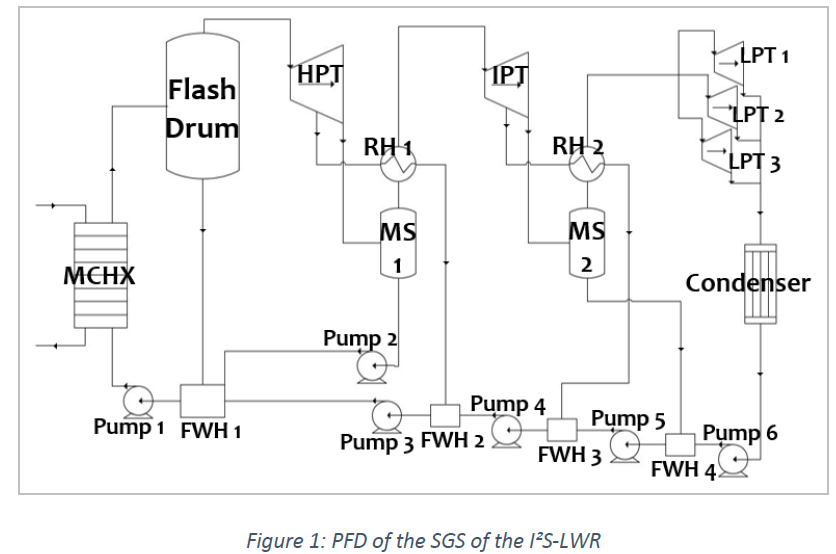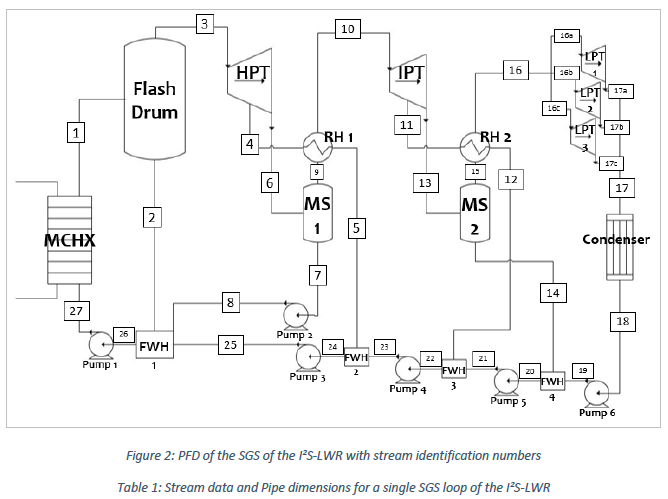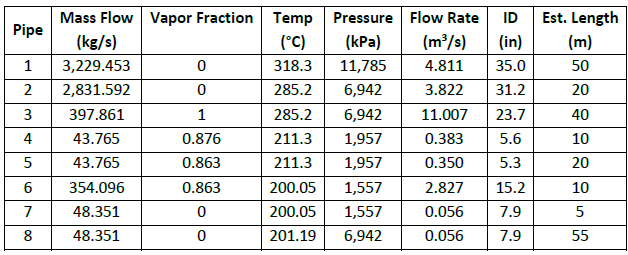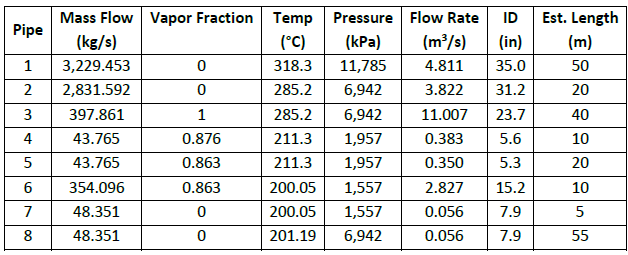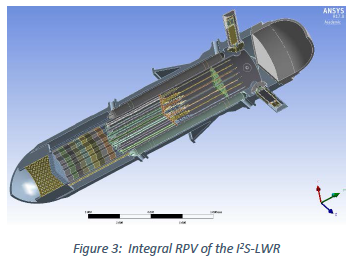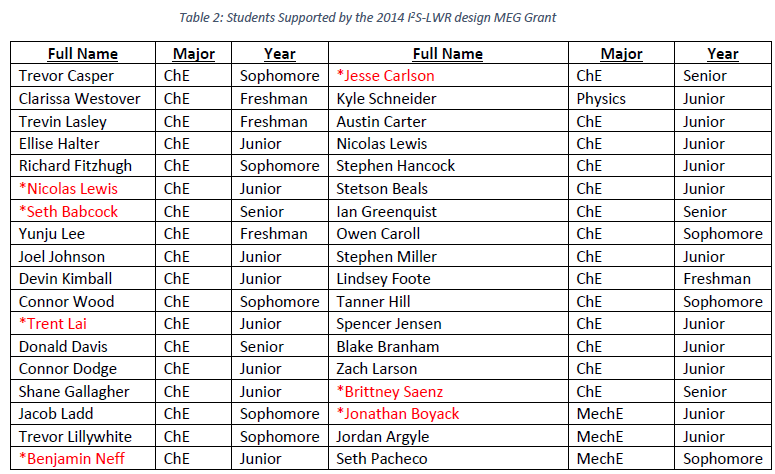Matthew J Memmott
Background
The goal of this project was to design a primary and secondary system of a light water reactor (LWR) capable of indefinite cooling in the face of design basis accidents. In a nuclear reactor system, the elements and isotopes that result from the fission of uranium atoms continue to generate heat even after the shutdown of the reactor. This heat, known as decay heat, must be continually removed from a nuclear reactor primary system for several months, otherwise the temperature will build, the fuel will melt, and the radioactive substances that are harmful to the public will be released. Currently, light water reactors worldwide rely on redundant, active safety systems in which operators can initiate equipment that will circulate water through the core to removed decay heat. However, if electricity is lost and backup systems are compromised, as was the case in the Fukushima Daiichi nuclear station accident in March 2011, then decay heat cannot be removed, and a release to the public may occur.
Although reactor designers have recently designed safety systems that don’t rely on electrical power or operator action, they are limited in scope and duration. Our goal is to develop a new reactor that uses passive safety systems capable of operating indefinitely, rather than for only a few days. This project is part of a larger DOE funded IRP in which 15 universities, industries, and national labs led by the Georgia Institute of Technology are tasked with designing a new LWR capable of indefinite passive cooling of the reactor during severe accident scenarios. The role of our group was to design both the primary and power generation systems of this reactor, known as the Integral, Inherently Safe Light Water Reactor (I2S-LWR).
Academic Objectives and Results
The academic objectives of this project were focused on the steps required to develop primary and power generation systems for the I2S-LWR. These objectives include:
1. Train students in developing system design tools
2. Mentor students in performing literature reviews
3. Teaching students to use design criteria to develop a nuclear system
4. Mentor students in optimization techniques
5. Help students understand the basic theory of nuclear safety analysis
6. Develop two separate systems for the I2S-LWR reactor
All of these objectives were accomplished over the course of this project, with the exception of the fifth objective, which is ongoing. The safety analysis mentoring was initiated through this MEG grant, but due to the complexity of nuclear safety analysis and RELAP5 modeling, this task is ongoing, with anticipated completion in late 2017. Perhaps more importantly, Paul Wilding has been effectively trained in nuclear design and optimization, and several students he helped to mentor obtained positions in the nuclear navy program, at Westinghouse Electric Company, and in other nuclear related industry jobs.
Paul Wilding, a PhD candidate in the chemical engineering department, lead this project, in which 4 separate groups of students performed design efforts for the primary and power generation systems of the I2S-LWR. These groups were the design optimization group, the primary system drafting group, the reactor coolant pump design group, and the secondary system design group.
The final results of this project included the design of the primary coolant system and the power generation system for the I2S-LWR. The primary system design primarily consisted of cad drawing, reactor coolant pump design, and reactor vessel stress analysis. The power generation system design consisted primarily of system design and multi-objective optimization. The resulting system designs are described next.
The steam generation system (SGS) for the I²S-LWR consists of four identical loops. Each loop is a Rankine-based power conversion cycle that features the use of a flash drum, a high-pressure turbine (HPT), an intermediate-pressure turbine (IPT), three low-pressure turbines (LPT), two moisture separators (MS), two reheater (RH) heat exchangers, a condenser stage, four open feed-water heaters (FWH), and six pumps. For a diagram of a single SGS loop, see Figure 1.
In a single loop of the SGS, the secondary coolant leaving the MCHX enters a flash drum, where approximately 10% of it turns to steam. The other 90% is joined with the rest of the condensate and recirculated through the MCHX. The steam enters the HPT as a saturated vapor. A portion is extracted to use as the hot stream in RH 1, to superheat the steam before entering the IPT. The exhaust steam exiting the HPT passes through a moisture separator, making it saturated once more before being superheated in RH 1 and entering the IPT. A portion of the steam is extracted from the IPT to use as the hot stream in RH 2, to superheat the steam before entering the LPTs. The exhaust steam exiting the IPT passes through a second moisture separator, making it saturated before being superheated in RH 2. The steam is separated evenly three ways and sent through the three LPTs. The 2-phase exhaust stream is completely condensed in the condenser stage. The resultant liquid is joined with the rest of the condensate via a series of open FWHs and pumps to be recirculated through the MCHX. The state points and equipment sizes previously obtained via design optimization result in a cycle thermodynamic efficiency of 34.97% for the SGS.
A detailed list of stream and pipe data are available in Table 8, where the numbering corresponds to the stream identification numbers found in Figure 2.
The primary system of the LWR was designed to be an integral system, in which all the components are located within a single pressure vessel. Unlike standard 2-4 loop LWRs, integral LWRs have effectively zeros loops; the entire primary system is contained within the RPV. A cutaway view of the I2S-LWR reactor pressure vessel can be seen in Fig. 3.
The I2S-LWR primary coolant system was designed to facilitate compact systems and components while maintaining safety, economics, and ease of maintenance. The RPV is the primary component housing each of the primary systems, and has been designed to accommodate the primary metrics indicated in section 2 of this paper. Each of the supporting systems described here has been evaluated and found acceptable in terms of both design and function for the I2S-LWR. Further design efforts will provide additional detail to the design of the primary coolant system, and will facilitate the development of a path to commercialization for the I2S-LWR.
The work funded by this grant resulted in two journal publications, one describing the development or optimization of each system:
1. M. J Memmott, P. R. Wilding, B. Petrovic, “An Optimized Power Conversion System Concept of the Integral, Inherently-Safe Light Water Reactor”, Annals of Nuclear Energy, (accepted 8/20/16)
2. M. J Memmott, A. Manera, J. Boyack, S. Pacheco, M. Wang, B. Petrovic, “The Primary Reactor Coolant System Concept of the Integral, Inherently-Safe Light Water Reactor”, Annals of Nuclear Energy, (accepted 8/20/16)
3. Evaluation of Mentoring Environment
The mentoring environment facilitated by the funds provided by the MEG grant provided excellent learning opportunities for all of the students involved, on both graduate and undergraduate levels. Significant amounts of training were required to understand the nuclear design requirements for reactor design, as well as the methodologies and simulation packages required to design a LWR primary coolant system. The following describes the structure of the work.
Paul Wilding, a PhD candidate in the chemical engineering department, lead this project, in which five separate groups of students worked to accomplish various tasks for the primary and power generation systems of the I2S-LWR. These groups were the design coolant property tool development group, the optimization group, the primary system drafting group, the reactor coolant pump design group, and the secondary system design group. Each group had a student leading the design effort, with 3-5 members of the team in addition to the team leader.
Throughout the project, Paul gained valuable experience in mentoring undergraduate research, and was able to help the students with simulation and modeling challenges, theoretical clarifications, and even interpersonal issues that arose. Each undergraduate student team lead was a junior or senior in the chemical or mechanical engineering programs, and each received mentoring from Paul while simultaneously providing mentoring to the younger undergraduates in their team. Additionally, each student was able to summarize their research in a report: team members submitted research reports to the team lead, who in turn submitted them to Paul Wilding and myself. Table 2 lists the undergraduate students supported by the MEG grant provided for this work, with team leads highlighted in red text with an asterisk prior to their names.
4. Project Expenditures
The funding from this grant was used exclusively to provide funding for the students involved in the project. Roughly $6000 was used to support Paul Wilding, the PhD candidate leading the project, while the remaining $14,000 was used to pay wages for the undergraduate students in each of the five groups.

